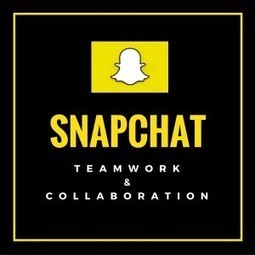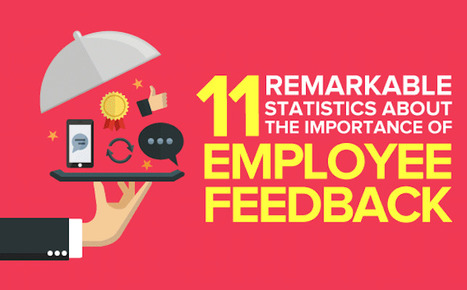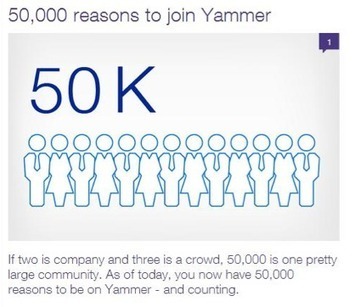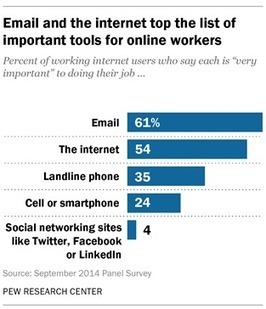 Your new post is loading...
 Your new post is loading...
I work in an office where I can get away with wearing flip-flops most days, but many women aren’t so lucky.
Women are often expected to wear high heels, and some companies even require it in their formal dress codes.
Of course, there’s nothing wrong with wearing heels. Sometimes it’s fun to feel taller and a bit more powerful. But this infographic shares the not-so-great reason women are still expected to wear stilettos. High heels have been viewed as feminine and sexually alluring over the years and are thought to command attention.
Earlier this year, an employee at PwC challenged her company’s dress code for requiring heels. The company changed its policy after public outcry and now allows flat shoes.
If you wear high heels too often, you may end up with back pain and weaker ankles. Employers can require employees to groom themselves, but there can’t be discrimination against one employee. Rules have to apply to every employee....
There’s a great quote from Confucius: “Tell me, and I will forget. Show me, and I may remember. Involve me, and I will understand." People will more readily help bring to life the changes that they are involved with. How are you involving your people in the changes that need to be implemented?...
Leaders of reorgs typically fall into one of two traps when communicating with their employees. We’ll call the first one wait and see and the second ivory-tower idealism. Perhaps you have seen one, or both, in your own reorgs.
In the first trap, wait and see, the leader of the reorg thinks everything should be kept secret until the last moment, when he or she has all the answers. The leader makes the reorg team and leadership swear to secrecy and then is surprised when the news leaks to the wider organization (it always does, we’re afraid). As the reorg team starts to engage with the rest of the organization, the rumors round the water cooler increase: “They were asking what my team does”; “I had to fill in an activity analysis form”; “I hear that 20 percent of jobs are going to go.” Everyone thinks the real reason for the reorg is job losses (whether it is or not). The leader, desperate to get in control of the situation, pushes the team to develop “the answer” so that he or she can tell the organization. Without an “answer,” the leader feels that any communication would come across as defensive. At most, the executive approves some question-and-answer sessions on the reorg. But a full-scale communication needs to wait. Eventually, the leader has the answer: the reorg team produces a high-level org chart. The leader then announces the new organization: here are the new leaders, here is the structure, some job losses are necessary, but this is going to help us deliver fantastic results. Employees, hearing this, hear only that their boss’s boss’s boss is going to change and that some of them are going to lose their jobs. Nothing their leader has said counters the impressions they formed at the water cooler.
Ivory-tower idealism fares little better. In this version, the leader of the reorg is finally getting a long-achieved objective: all the issues of the old organization will finally get fixed; everything the leader wanted to do, but was held back from, can now be achieved. The leader can barely contain the excitement. So psyched up by the possibilities that the reorganization offers, the leader decides to start the process with a webcast to all staff, telling them about the exciting business opportunities it will open up. The leader follows this up with a series of walk-arounds in the major plants and offices, discussing the opportunities and getting input on some of the challenges that people face in the organization today. The leader puts a personal blog on the company intranet....
The idea is to simply turn your employees into brand advocates on social and leverage their social connections to crank up your social reach exponentially.
Running an employee advocacy program isn’t a textbook strategy. There’s no set method that will work for everyone, and you’ll have to build your program to fit your own business from scratch.
So what’s the most effective way to do that?
Let’s first break down the definition of social employee advocacy and then study the essential elements of most successful advocacy programs.
Enhancing the employee experience includes reassessing employees’ physical, cultural and technological environments. The experience works to validate the brand promise, reinforce understanding of and commitment to the business strategy, and add to an employee’s professional and personal growth and well-being.
Based on our experience working with clients as well as what we heard in our recent conversations with employee engagement leaders, below is a summary of considerations and suggestions for how to make your communications with employees more effective....
Snapchat has become one of the most popular and talked about platforms for 2016. Even during the Super Bowl, we saw brands such as Marriott, Amazon, and even Gatorade jump on board, with ads just on Snapchat. In addition, there areother brands that advertised during football’s biggest night that you may want to check out.
While Snapchat has been used for brands and other public relations campaigns, it can be used for collaborative and teamwork efforts as well. In fact, I used Snapchat for the first time this semester to not only showcase what I am doing in my classes, but also to document, share, and collaborate with my students and fellow PR professors on projects and assignments.
Here are some ideas to consider for how to use Snapchat for collaboration and teamwork feedback:...
There is a lot of research and opinion on what ingredients are necessary to build a high-performing team because it is one of the most difficult things to do -- you are essentially forcing people together -- but it's one of the biggest drivers of success in an organization. A poor performing team can negatively impact an entire organization, not to mention be the cause for missing goals or revenue targets.
Weekdone created the below infographic detailing some of the defining characteristics of great teams. Learn what you should look for in a high-performing team and how to recruit to create your own. ...
The workforce shift from baby boomers to millennials is creating a sense of urgency for small and large company leaders to focus on culture, as talented, creative employees search for a place where they fit in, feel valued, and enjoy what they are doing.
To figure out how to identify the right interactions to promote, CultureIQ measures 10 different operational and strategic company qualities. Shanklin said that three are most important: support, work environment, and mission and value alignment.
“It’s really about a company’s response to employee input,” he said. “And resources — people feeling that they’re equipped to do their jobs. When it comes to the mission and value, it doesn’t matter so much what those are, just that they exist, are clear, and the leadership models them.”...
Days after taking over as Twitter’s permanent CEO, Jack Dorsey has laid off 336 people. You could learn a lot from the straightforward, honest, and sensitive way he tells his company about it.
The corporate layoff is a communications trap for leaders. It makes them insecure, so they they adopt HR bullshit and talk about “reduction in force”, “rightsizing”, “eliminating positions.” But they don’t have to. Here’s how Jack Dorsey told Twitter he was letting a big chunk of the company go....
The infographic that we put together has some pretty shocking statistics in it, but there are a few common themes. Employees feel overworked, overwhelmed, and they don’t like what they do. Companies are noticing it, with 75% of them saying they can’t attract the right talent, and 83% of them feeling that their employer brand isn’t compelling. Companies that want to fix this need to be smart, and patient.
This doesn’t happen overnight, but like I mentioned, it’s easy to do. Being patient might be the hardest thing for companies, and I understand how frustrating it can be not to see results right away, but it’s important that you invest in this, because the ROI of employee engagement is huge.
Here are 4 simple (and free) things you can do to get that passion back into employees. These are all based on research from Deloitte....
It's every manager's responsibility to provide meaningful feedback on a regular basis. And that doesn't mean waiting for the annual review to roll around: Employees that are highly engaged at work receive employee feedback at least once a week.
But giving feedback regularly isn't just beneficial for the employee -- it's beneficial for the team, too. Did you know that receiving feedback can actually inspire your employees to work harder and become more engaged? In fact, 69% of employees say they would work harder if they felt their efforts were being better recognized. Employees who receive little or no feedback from their managers tend to disengage from their work more readily....
Executives have attempted to soften the blow of discussing layoffs over the years by using new terms, such as “offboarding,” “rightsizing,” “smartsizing” and “streamlining.”
Yahoo CEO Marissa Mayer coined another this week on a conference call with reporters and analysts: “remix.”
According to Dice, Mayer said the 1,100 net layoffs the company had in the first quarter of 2015 were part of a “remixing and pivoting” of the company....
When it comes to engaging employees on the journey to enterprise social, getting 75,000 employees or 50% of your staff to actively use one network is about as ambitious as it gets.
Veyronique Vallieres, Internal Communications and Community Manager at ABB, worked a long time on adoption as part of the company's vision to break down internal silos and enable greater collaboration across 100 countries.
"We are one of the global leaders in power and automation technologies providing literally thousands of products and solutions to reduce environmental impact around the world. Being aligned internally as an organisation is not only crucial, it is essential."...
|
Employee advocacy is taking corporate communications by stormr. Encouraging employees to be your organization's champions could be the perfect answer to journalists increasingly seeking real stories on social media. Companies like Cisco and Danske Bank are already experimenting with employee social-media takeovers. Don't sack your spokesperson, but it's definitely time to give your employees the forum they deserve....
Consider this statistic: employees are 2x as trusted as a CEO, senior executive, or activist consumer (Edelman). If that stat didn’t drive the importance of employee advocacy home for you, how about this: on average, brand messages are shared 24x more frequently when distributed by employees (MSL Group).
Employee advocacy is increasingly being seen as a key accompaniment when considering social media management solutions – and many established solution providers have adapted as such, whether as an add-on to their already existing services, or a tool that easily integrates across other CRM platforms.
The challenge for marketers, then, becomes choosing a solution that’s both scalable and that allows you to tie employee advocacy initiatives directly to ROI.
What investment can you make that maximizes your time while equipping your employees to be your most powerful brand advocates?
We’ve gathered 10 of the top employee advocacy tools available that combine a rich mix of features to suit a variety of company needs and goals....
We surveyed approximately 9,800 full-time workers, ages 19 to 68, in Brazil, China, Germany, India, Mexico, Japan, the UK, and the U.S. Our most striking finding was that fewer than half of all surveyed professionals have a high amount of trust in their companies: Only 46% place “a great deal of trust” in their employers, and 15% report “very little” or “no trust at all.” (The rest, 39%, say they have “some trust,” which is not completely pessimistic but does want for enthusiasm.) There clearly is room to improve for all of us, and companies (including EY) should pay attention to what’s discouraging the most distrusting group of workers. Among those with little or no trust in their employer, the top five reasons were: “Employee compensation is not fair,” their employer “does not provide employees with equal opportunity for pay and promotion,” there’s a “lack of strong senior leadership,” “too much employee turnover — voluntary and/or involuntary,” and the employer does not foster a “collaborative work environment.”...
Joel Gascoigne, CEO of social media tool startup Buffer, shared a 3500-word post in which he explains why he’s laying off 10 of his 94 employees. In contrast to bloodless posts from the likes of Inteland Microsoft, it indulges a different sin: oversharing. A lot of my correspondents forwarded Gascoigne’s post to me, hoping I’d praise it because it is so different from the other CEO communications I’ve shared. And there is a lot to like here: it’s extremely open, fair, and honest. Gascoigne is living his sincere promise to be transparent. But a CEO should be communicating the realities of his or her business regularly, not dropping it all at once in a 3500-word lump along with a layoff. What a team wants from their CEO is to share what’s relevant, not to share everything. This is a good example of how it’s possible to overdo transparency....
Work customs and culture vary from country to country. For instance, meeting attendees in the U.S. seat themselves in no particular order around the conference table. But if the most junior person on the team were to take the seat farthest from the door in Japan? That's a no-no. This behavior flies in the face of Japanese custom, where the seating arrangement is determined by professional seniority (the most senior people sit farthest from the door, and the most junior people closest). But while there are no doubt differences in work styles around the world, there are also similarities. After surveying nearly 200 leaders located in 15 different countries, Quantum Leadership Group recently discovered the most important leadership trait worldwide: High ethical and moral standards.In a Harvard Business Review article covering the data, Sunnie Giles, president of Quantum Leadership Group, categorized this response along with the third most important trait ("clearly communicates expectations") as qualities that "creat[e] a safe and trusted environment."...
Neill said that a number of trends “indicate a move to a more strategic role for internal communication and more dialogue with employees rather than one-way communication.” Those developments include:
• Organizational structural changes. For most companies and organizations that participated in the study, a communications or public relations department leads their internal communications, with human resources professionals collaborating closely.
• Generational shifts. The loss of baby boomers in the workplace means losing years of experience. Millennials have different communication expectations from their employers, such as mobile communication and short messages. Companies and organizations are learning to communicate with brevity and easy access through channels such as internal social media....
To start, agencies need a better idea of how happy, fulfilled, challenged, and dedicated employees are. They need to understand the health of their company culture and how employees perceive the organization. They also need a system for eliciting feedback and tracking satisfaction and issues over time. Only with this information can leadership address issues, make changes, and improve their agency's employee engagement.
To get you started gathering this information, we've put together a list of some of the best employee feedback and culture tools. Check them out to see which one might help you make improvements in your own firm....
The job skills gap doesn’t necessarily mean employees aren’t grasping new software or can’t complete a new technical task. More often it refers to soft skills: communication, creativity, critical thinking and collaboration. Learn what managers and millennials (those born between 1980 and the early 2000s) expect and deliver in today’s workforce.
Today, with all the internal communication tools available to a workforce, emailing seems almost primitive. Though many organizations still use email, most are trying to reduce the number of emails sent in favor of a simpler, more efficient form of internal communication. Employees are relying more on intranets or enterprise social networks.
Rio Rancho Public Schools has eliminated routine "all staff" emails, such as weekly school bulletin updates, by posting such important news on the intranet. (Here's the RRPS case study.)
Though you might not be ready to eliminate every "all staff" email and all one-on-one emails, you can improve internal communications with these powerful tools:
It’s the age-old conundrum for leaders and managers—we want to have motivated employees and we want their engagement, but do we have enough resources, the right people? Are we treating them right? How can we know?
Here’s how one tech support manager handles this challenge.
She just asks.Instead of worrying, guessing, and engaging in trial and error, Katie Douthwaite asks her teams the following four questions....
If you’re the kind of boss who fails to make genuine connections with your direct reports, take heed: 91% of employees say communication issues can drag executives down, according to results from our new Interact/Harris Poll, which was conducted online with roughly 1,000 U.S. workers.
In the survey, employees called out the kind of management offenses that point to a striking lack of emotional intelligence ;among business leaders, including micromanaging, bullying, narcissism, indecisiveness, and more. In rank order, the following were the top communication issues people said were preventing business leaders from being effective....
The internet and cell phones have infiltrated every cranny of American workplaces, and digital technology has transformed vast numbers of American jobs. Work done in the most sophisticated scientific enterprises, entirely new technology businesses, the extensive array of knowledge and media endeavors, the places where crops are grown, the factory floor, and even mom-and-pop stores has been reshaped by new pathways to information and new avenues of selling goods and services. For most office workers now, life on the job means life online.
|




 Your new post is loading...
Your new post is loading...








![What Makes a Team Truly Great? 9 Defining Traits [Infographic] | Public Relations & Social Marketing Insight | Scoop.it](https://img.scoop.it/V8CzC9nPiFIXGJJ6yXtWozl72eJkfbmt4t8yenImKBVvK0kTmF0xjctABnaLJIm9)












![#1 Most Important Leadership Trait Worldwide [New Research] | Public Relations & Social Marketing Insight | Scoop.it](https://img.scoop.it/vgzkn_Ad1P5VA3FyUoDE2zl72eJkfbmt4t8yenImKBVvK0kTmF0xjctABnaLJIm9)












The painful truth about high heels and why some employers need to walk a mile in these high-heeled shoes.